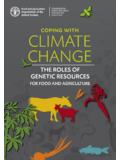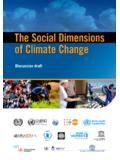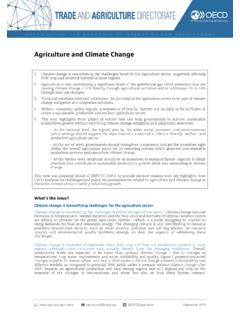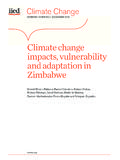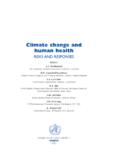Transcription of TRENDS IN PRIVATE SECTOR CLIMATE FINANCE - …
1 TRENDS IN PRIVATE SEC TO R. CLIMATE FINANC E. R E P O RT PREPARED BY T HE CLI MAT E CHA NG E. S U P P O RT TEAM OF TH E UNI T ED NAT I ONS. S E C RE TARY GENERAL ON T HE PROG R ESS. M AD E SINCE TH E 2014 CLI MAT E S UMMI T. 9 OC TOBE R 2 0 1 5. Disclaimer This publication is an advance unedited version produced by the CLIMATE change Support Team (CCST) of the UN Secretary General. The CCST and the presenta- tion of the material in this publication do not imply the expression of any opinion whatsoever on the part of the United Nations, its inter-governmental bodies and the United Nations system. Moreover, the views expressed do not necessarily repre- sent the inter-governmental decision or the approved policy of the United Nations, nor does citing of trade names or commercial processes constitute endorsement.
2 This advance un-edited version may be reproduced in whole or in part and in any form for educational or non-profit purposes without special permission, provided acknowledgement of the source is made CLIMATE change Support Team, which would appreciate receiving a copy of any publication that uses this publication as a source. No use of this publication may be made for resale or for any other commercial purpose whatsoever without prior permission in writing from the designated entity. TRENDS IN PRIVATE SEC TO R. CLIMATE FINANC E. R E P O RT PREPARED BY T HE CLI MAT E CHA NG E. S U P P O RT TEAM OF TH E UNI T ED NAT I ONS. S E C RE TARY GENERAL ON T HE PROG R ESS. M AD E SINCE TH E 2014 CLI MAT E S UMMI T. 9 OC TOBE R 2 0 1 5. CO N TE N TS.
3 Executive summary 6. 1 Introduction 8. 2 Commitment is growing 11. 3 Markets are shifting 18. 4 Transforming rules 37. References 44. End notes 47. Ackowledgements 48. LIST OF TA B L E S. Table 1 PRIVATE SECTOR commitments and targets made at the UN Secretary-General's 14. CLIMATE Summit are on track to being delivered Table 2 There have been more than ten important announcements relating to financing 15. of CLIMATE change activities in the last year 4 TRENDS in PRIVATE SECTOR CLIMATE FINANCE LIST O F F I G U R ES. Figure 1 All aspects of the investment and financing ecosystem will require change to 10. support the low-carbon CLIMATE -resilient transition Figure 2 Non-OECD countries have driven much of the increase in renewables 19.
4 Investment in recent years Figure 3 The risk premium for European onshore wind projects has fallen since the start 21. of 2013. Figure 4 The issuance of labelled and unlabelled green bonds has risen substantially in 23. recent years Figure 5 The market for CLIMATE -aligned bonds has issuers from a diverse range of 24. countries Figure 6 The number of shareholder resolutions relating to the low-carbon transition is 25. increasing Figure 7 The cumulative number of low-carbon indices has grown rapidly in the last 28. decade Figure 8 In both developed and developing countries, the proportion of insured weather- 31. related losses has grown Figure 9 Across the FINANCE ecosystem, there are early signs of a fundamental shift 36. Figure 10 The share of global emissions subject to a carbon price has grown rapidly in the 39.
5 Last five years LIST O F B OX E S. Box 1 Changes in Yes Bank: a microcosm of the shifts in the banking community 16. Box 2 Supported by PRIVATE SECTOR investment, South Africa is fundamentally 20. reorientating its energy system towards renewables Box 3 Developments at Aviva: a microcosm of the shifts in understanding the 33. investment impacts Box 4 Changes at Fj rde AP-fonden (AP4): a microcosm of the shifts in the asset owner 29. community Box 5 ACRE (formerly Kilimo Salama): an example of an index-based microinsurance 30. product TRENDS in PRIVATE SECTOR CLIMATE FINANCE 5. E X E C U T I VE S U MM A RY. The FINANCE community is emerging as a partner models in response to the commercial opportunities in the challenge of responding to CLIMATE change and challenges posed by CLIMATE change .
6 Slowly but policy makers have an opportunity to both deepen surely, at least in leading financial institutions, CLIMATE and broaden this partnership. Actors from across the change is becoming a mainstream driver of invest- SECTOR and in all geographies are recognizing both the ment strategy. threats that CLIMATE change poses, but also the commer- 2. A new green bond market has been created and cial opportunities it provides. They are responding is expanding at a rapid pace. Six years ago, green with action, as illustrated by five key inflection points', bonds were a concept. In 2015, it is expected that described below. The resulting momentum is in distinct issuance will be between $50 and $70 billion. This contrast to the situation in the run up to COP 15 in will support new low-carbon or CLIMATE -resilient Copenhagen.
7 But gaps in PRIVATE SECTOR CLIMATE finance1 investment in the energy, buildings, transport and remain: investment levels remain too low; not all coun- water sectors. Originally spurred by development tries are seeing benefits; and leadership by some in the banks, green bonds are now issued by utilities, car SECTOR is matched by inertia from others. Filling these manufacturers and a host of other corporates. In gaps will, in turn, necessitate governments to address 2015, many of the most significant positive develop- weaknesses in their own policy responses, requiring ments spurring the green bond market have arisen in both national action and international cooperation. emerging economies. 3. A rapidly increasing number of companies are The momentum in the SECTOR was given a substan- adopting internal carbon prices.
8 The vast majority tial boost at the 2014 CLIMATE Summit hosted by the of PRIVATE SECTOR investment is made by companies UN Secretary-General in New York. This prompted re-investing free cash flows. It is therefore hugely a series of specific, quantified commitments and targets significant that, according to one estimate, the from across the SECTOR , involving both individual number of firms using internal carbon prices has companies as well as organizations acting in partnership. trebled in just the last year to almost 450 (CDP, As shown for the first time in this report, the majority 2015). By market capitalization, around 15 per cent of these commitments and targets have been met or are of the S&P 500 factor in a price on carbon when on track to being delivered.
9 Undertaking investment appraisal. A further 580. The five inflection points' demonstrating the early companies anticipate introducing an internal carbon signs of a deep shift cover all the key aspects of price within the next two years. the SECTOR : 4. Investors are expressing increasing concern around the activities of carbon-intensive assets and companies. Driven by initiatives such as the 1. Building on the targets and commitments Portfolio Decarbonisation Coalition launched last announced at the 2014 CLIMATE Summit, a range year, investors have made commitments to decar- of financial institutions from developed and bonize broader market portfolios worth hundreds developing countries have recently committed of billions of dollars, and they have developed the hundreds of billions of dollars in additional investment strategies and instruments necessary to FINANCE to support low-carbon and CLIMATE -re- do so.
10 Furthermore, in the last year alone, investors silient investments in all parts of the world. This have also committed to tracking the carbon perfor- capital will FINANCE investment in both developed mance of assets under management (AuM) worth and developing countries to reduce emissions and trillions of dollars, and have increased engagement improve CLIMATE resilience while providing energy, with carbon-intensive companies to encourage reducing air pollution and delivering a host of other more sustainable business strategies. In the extreme, benefits. In addition to mobilizing traditional invest- a number of investors are turning to divestment. ment instruments, investors have experimented with Collectively, these actions are sending powerful long- a range of new and innovative financing approaches.










